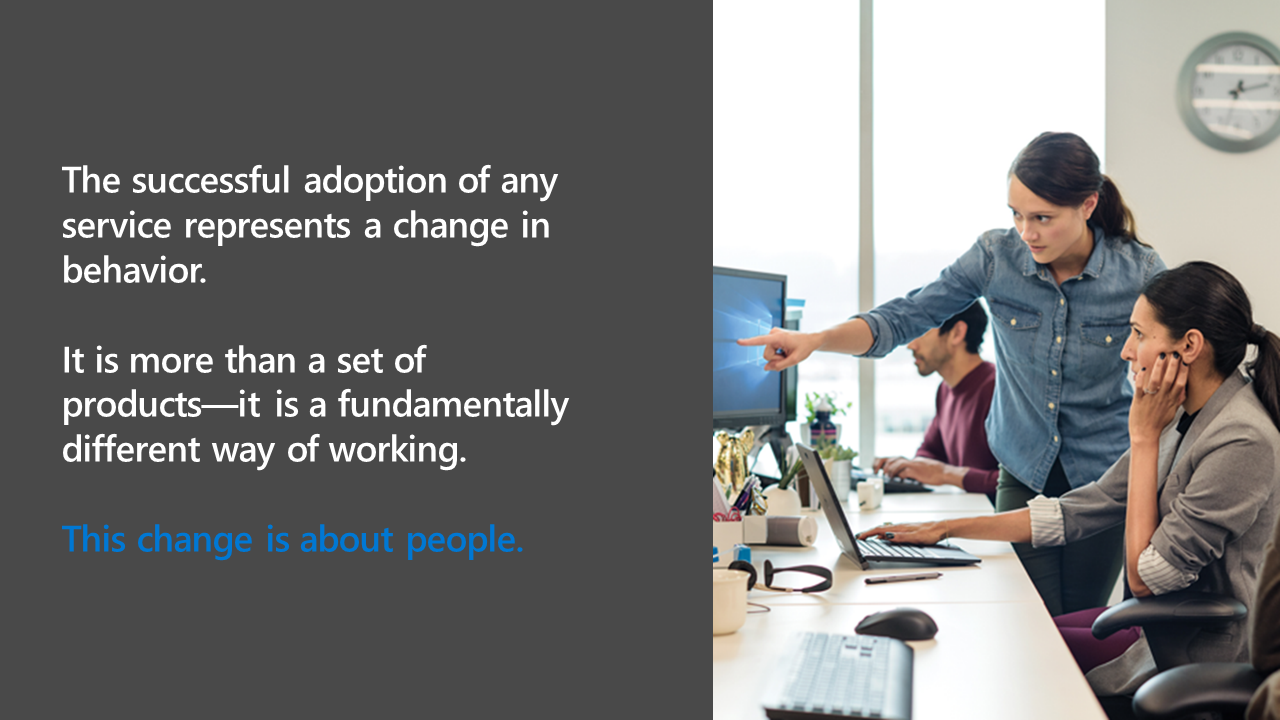Key knowledge areas - learn what you need to know
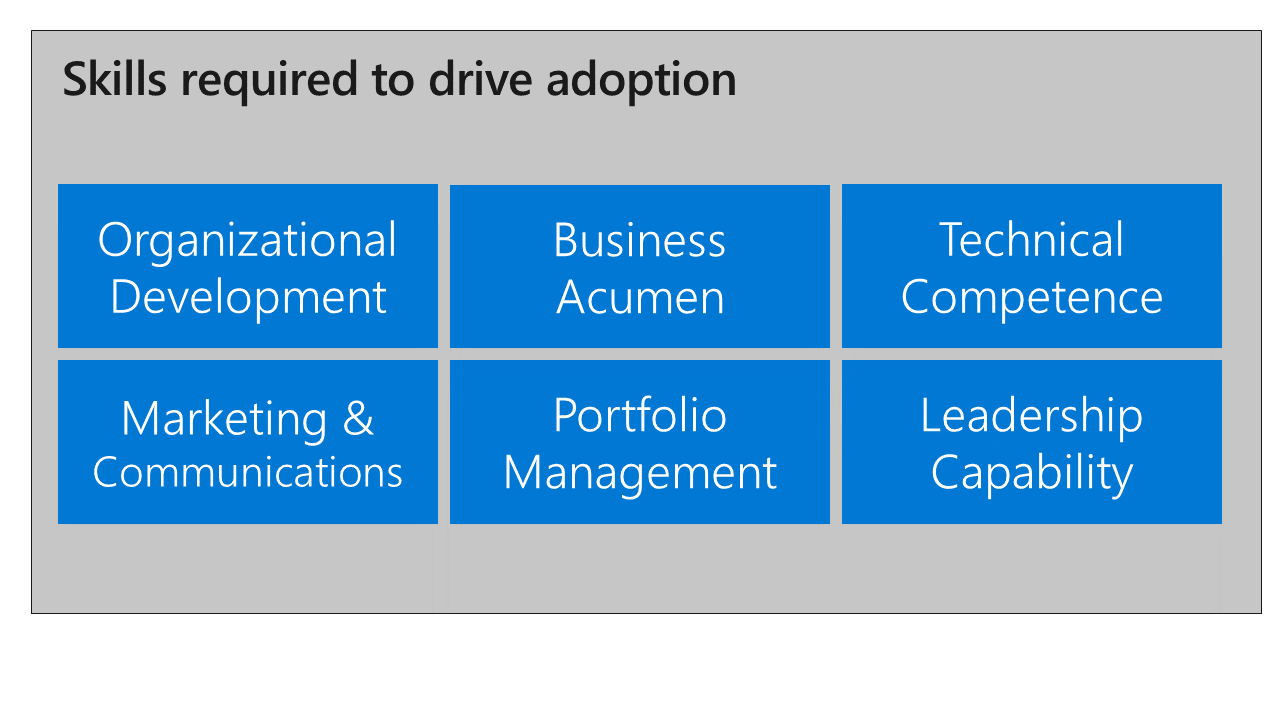
Service adoption refers to the ability of an organization to drive healthy usage of the business and technical capabilities of a service. Healthy usage refers to employees using the service to deliver business outcomes in their organization. Your employees' experience and digital literacy with tools and processes are essential to healthy usage.
This training highlights the partnership between IT and business. We usually focus on both the organization and the employee when tackling an organizational change. In service adoption the employee's experience - their technical capabilities and reliability, ease of use, and how the service applies to their daily life - is an integral part of the process. In a successful service adoption, both the technical and user needs are addressed and integrated into the overall project plan.
As a Service Adoption Specialist you're at the center of driving human and technical changes to deliver business outcomes. This role has evolved as businesses and technology have increased in pace and complexity.
There are six knowledge areas required to drive adoption. They are:
- Organizational development
- Business acumen
- Technical competence
- Marketing and Communications
- Portfolio management
- Leadership capability
Mastering each of these areas increases in complexity depending on the size and regional distribution of your organization.
Note
Before proceeding make sure you've read the Read before proceeding section in the the previous unit. We'll be using these assumptions as we discuss the practical application of the knowledge areas above.
Knowledge area - Organizational development
As a Service Adoption professional, you're at the nexus of driving organizational and behavioral change for your company. At its heart, this change is about people. Centering your project, priorities, and enthusiasm around people can help sustain the energy required to lead this change.
Organizational change is when an organization must change its strategies, processes, culture, or technologies. Change happens at different paces in a company. Members of the executive suite, given their experience, may adapt to change more readily, especially if they are spurred by competitive pressure. On the other hand, in many organizations, the remote employees, accustomed to solving issues for themselves, most quickly adapt to change.
What's common knowledge in the executive suite isn't always common to most employees in their day-to-day work. This doesn't mean that individual employees don't care about company strategy or initiatives. In fact, they generally care very much. But sweeping high-level statements from execs often miss what's important to individual employees. Then middle managers, who are often ill-equipped or under too much pressure to deliver results, must bring out the nuances of communication. It's important to know the baseline knowledge of the employees you are attempting to serve. Assessing their knowledge is a fundamental step to crafting a successful adoption plan and will be discussed further in following modules.
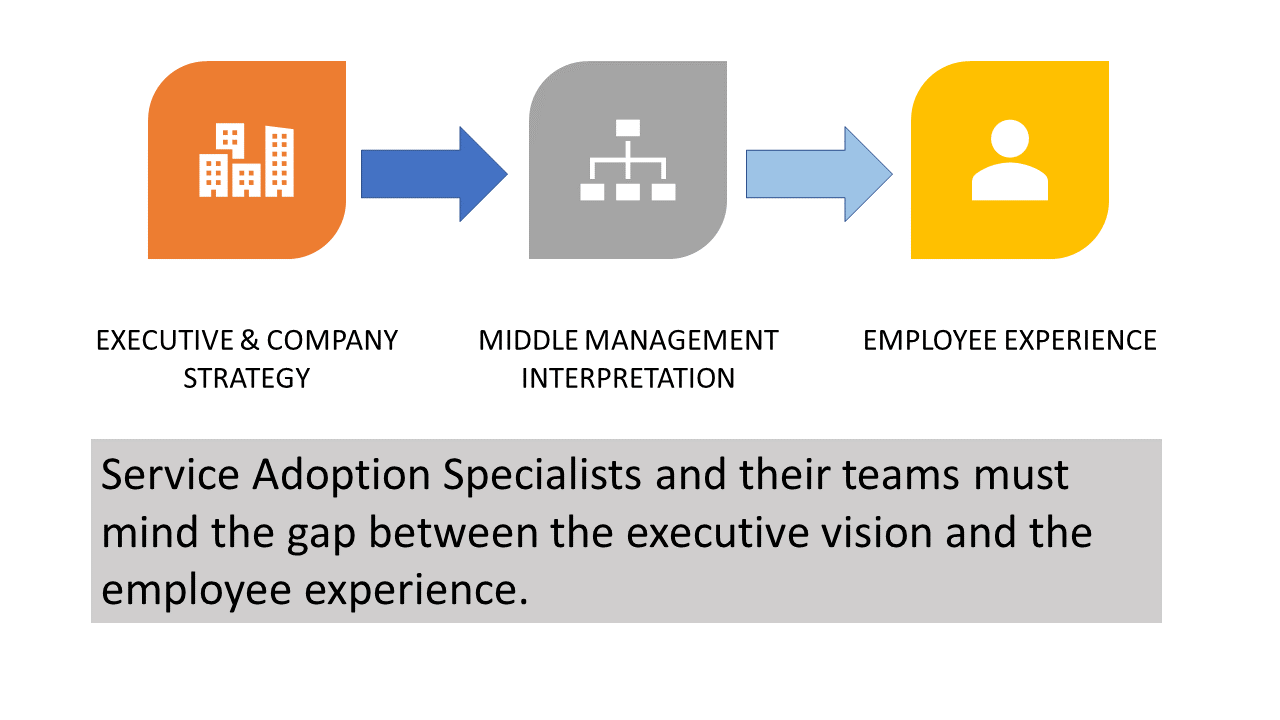
As in any relationship listening is the most important skill, you'll develop in this role. There's no replacement for empathy when your goal is a superior employee experience. Without listening systems, employee surveys, and conversations over lunch and at the water cooler, you won't have the relevant information to carry out your duties. In your new role you must:
- Bridge the gap between company strategy and day-to-day employee experience
- Be open to feedback of what is and more importantly is not working for employees
- Balance change with business outcomes
- Advocate for the employee experience
- Find and keep your sense of humor
Knowledge area - Business acumen
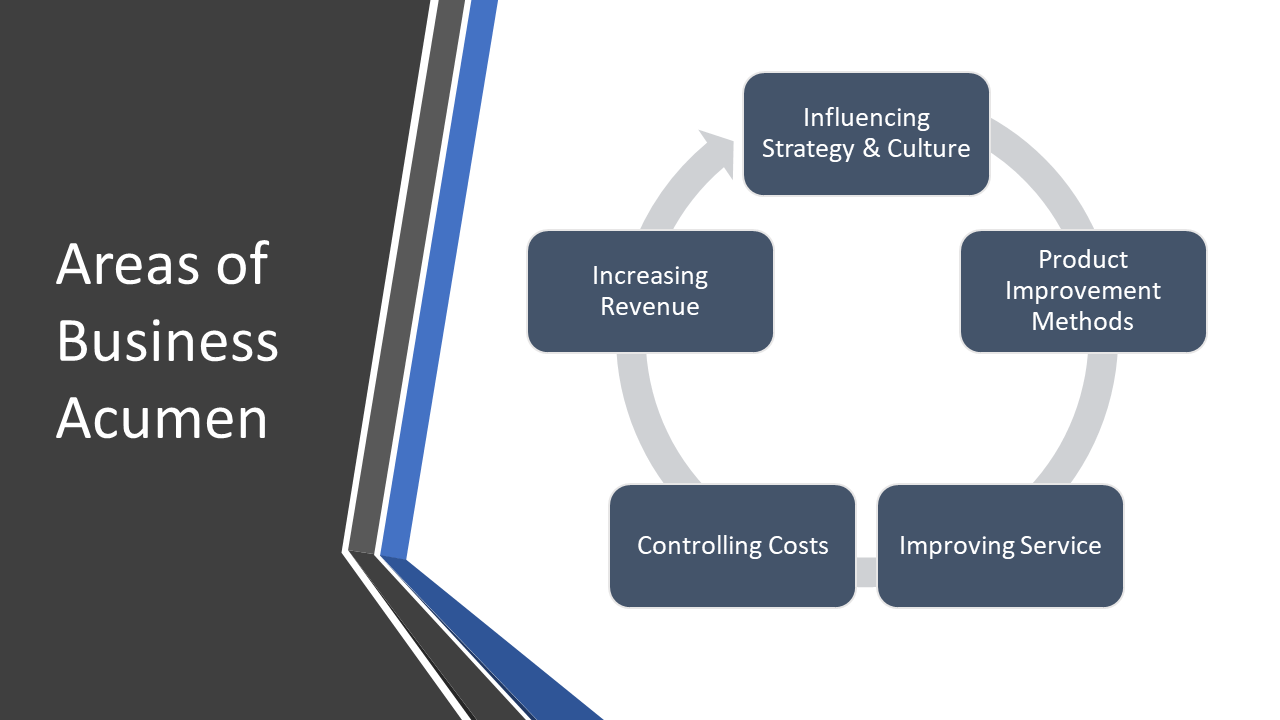
Many Service Adoption Specialists come from the marketing or communication sides of an organization. This is often because they've had success driving change in other areas in the past and are now tasked with a larger initiative. Although this initiative might not be directly related to technology, they may be tasked with product or service improvements and therefore need better technology to deliver on this goal. Those who come from IT backgrounds also have detailed knowledge of the state of the organization and its ability to respond to market changes and customer demands. Whatever your background you need a deep understanding of the strategic, competitive, cultural, and financial needs of your business.
It's essential to understand the imperatives of your company as this is the "connective tissue" between the technology change and the behavioral motivation needed to deliver change. Every organization has goals. Altering the strategy and culture of a company can spur product and service improvements. Every commercial enterprise must control costs while also increasing revenue. (While these outcomes might not apply to certain not-for-profit or governmental organizations, these organizations have their own initiatives.)
Developing business acumen isn't a one-time activity. It continues over the course of your career. You'll develop skills to address issues with greater complexity by observing business processes, speaking with employees in various roles and at different levels of seniority, and researching your own industry competitors to understand their approach to business transformation. Don't forget that the best teacher is a perceived failure. Often "failures" can spur the greatest transformations when viewed as a learning opportunity.
The five areas of business acumen are:
- Influencing company strategy and culture
- Product improvement methods
- Improving service
- Controlling costs
- Increasing revenue
If you're unfamiliar with the top initiatives of your organization: STOP! Step away from this training, and go find out what is most important to your company. Consider these key perspectives in the following order:
- Your customers
- Your employees
- Your executives
Successful organizations put the customer's needs at the top of the priority list. This should then be balanced with the needs of the employees to deliver on customer needs. Finally your executives have a vision and specific needs that you must weave into the customer and employees' objectives.
Your ability to execute an adoption program must be steeped in the language, challenges, objectives, and outcomes of your business. There's no substitute for homework in this knowledge area. Your knowledge must be directly applicable to the organization, business unit, or employee role you are attempting to help.
 Find a person in your organization who led a project that was not viewed as "successful." After validating with them their perspective, ask them what they learned. Make it clear you are there to learn, not to judge their experience. Often you'll find people keen to share their learnings with an interested party. After your conversation, ask yourself these questions:
Find a person in your organization who led a project that was not viewed as "successful." After validating with them their perspective, ask them what they learned. Make it clear you are there to learn, not to judge their experience. Often you'll find people keen to share their learnings with an interested party. After your conversation, ask yourself these questions:
- How can this lesson help others?
- What would I do differently?
- Could better technology or communication have changed the outcome?
- Could better technology or communication have changed the perception of the outcome?
Knowledge area - Technical competence
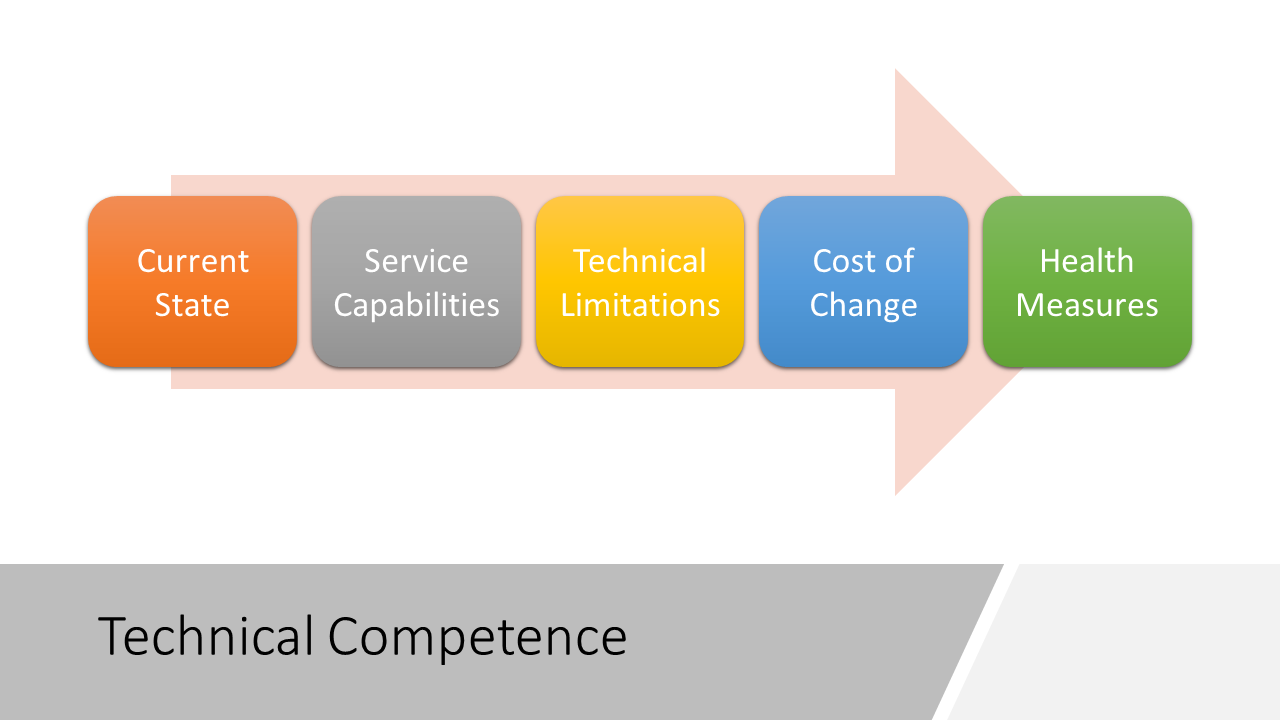
Technical competence is the depth of knowledge required to apply specific technology to a business problem to achieve a desired outcome. Without understanding what you can do, how you can do it, and how much it costs, you can't judiciously use technology in your organization. It's critical that you don't focus on new features simply because they exist, but instead focus on how you can make your employees' lives easier with the right technology.
This requires study. Don't be daunted by this knowledge pillar if you don't have an IT background; you don't need a computer science degree to achieve the appropriate level of knowledge. What's relevant in this area is hands-on knowledge applicable to the business scenario you are trying to improve. You can also use the partnership of a willing IT professional to help with another important element: the cost of change.
Technology changes can be expensive far beyond the cost of the hardware or software. Employee training, technical training, configuration and deployment time, updating customer and executive expectations, and ensuring service health and reliability are all components of the cost of change. Take the necessary time to understand the new technology and, whenever possible, bring the voice the employee to the table. You also need to balance initial vs long-term change costs. For example, building the digital literacy of your employee base using out of the box tools will reduce change costs in the future. Incorporating process changes as you teach the new tools will minimize the disruption of small but frequent incremental changes.
Optional activity
 Buy yourself a subscription to Microsoft 365. You'll have access to all the administrative tools and workloads that you might use in your work environment. The monthly subscription cost is a small investment in your career and gives you a safe environment to learn in. Alternatively, ask your IT department if they have a "test" or "development" tenant where you can be a user with administrative rights so that you can learn on your own. For many of us there is no alternative to hands-on learning. You can also use other online Microsoft learning experiences that have labs attached so you can build out your own solutions.
Buy yourself a subscription to Microsoft 365. You'll have access to all the administrative tools and workloads that you might use in your work environment. The monthly subscription cost is a small investment in your career and gives you a safe environment to learn in. Alternatively, ask your IT department if they have a "test" or "development" tenant where you can be a user with administrative rights so that you can learn on your own. For many of us there is no alternative to hands-on learning. You can also use other online Microsoft learning experiences that have labs attached so you can build out your own solutions.
Knowledge area - Marketing and communications
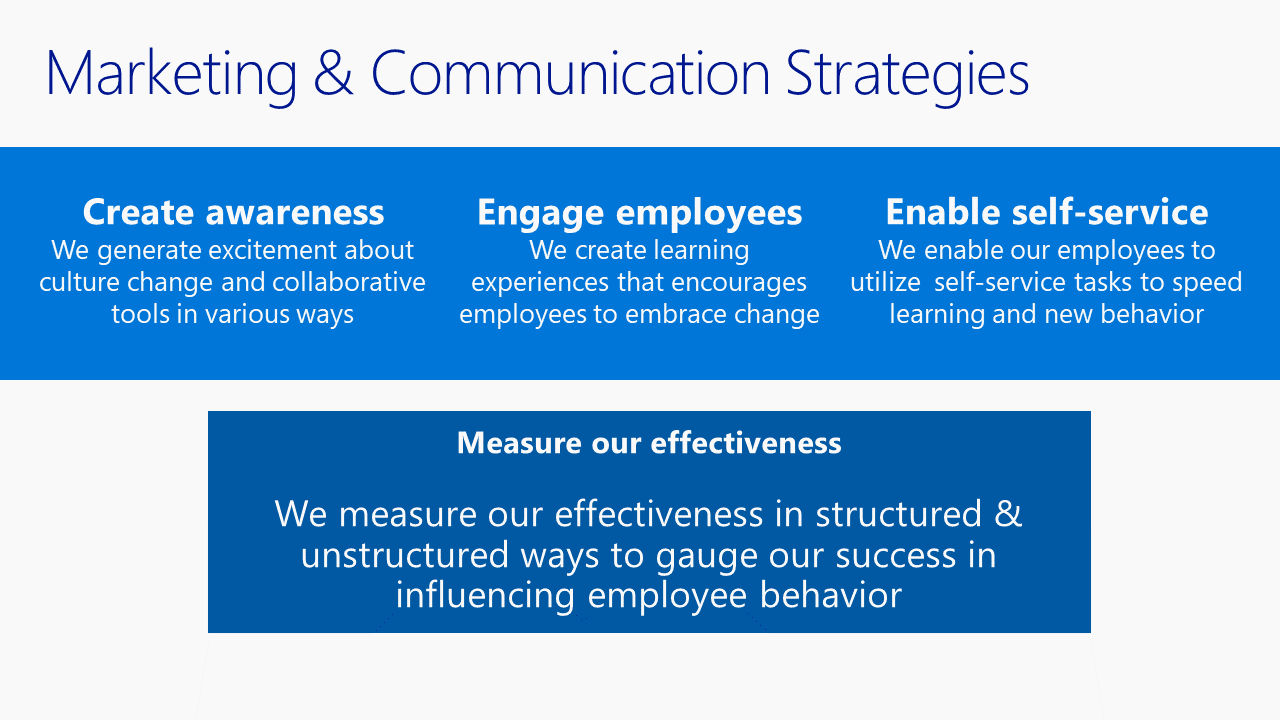
Slide showing three areas; Create awareness, Engage employees, and Enable self-service. These are above Measure our effectiveness.
Since service adoption is a human-centered activity, a critical knowledge area focuses on marketing and communications. If you can't communicate why a change is beneficial, you can't convince employees to participate. Not many IT departments have marketing communication specialists. Often a communication specialist is confused with training specialists, but these are two very different skills. In the context of service adoption, you need to be able to communicate why, when, where, and how the change will occur in a creative and appealing way. Your goal is to get participants in the change and increase the pace of adoption throughout the organization. Often employees resist change because no one's explained the change in terms that are meaningful to their experience. You can change that!
The marketing and communications area involves:
- Creating awareness of the change
- Engaging with employees through omni-directional communications
- Finding useful ways to enable self-service learning
- Measuring the effectiveness of these methods
Remember, communicating is not outbound only! You need to set up feedback systems to get information back from employees. You'll use this data in the service health segments of your plan. Feedback systems include enterprise social networks like Viva Engage, periodic employee surveys, regular office hours, and other online forums for discussions.
Communication in the context of service adoption does NOT mean sending an email to your employees and making sure they know the help desk extension number! If that's the extent of your communications plan, your change plan will encounter severe difficulties. Omni-directional marketing means simultaneously using multiple communication methods to communicate the why, what, where and when of change on a regular basis. Some of those communication methods include email, posters, events, internal social networks, digital news, and all-hands meetings.
Superior communication can overcome the most difficult of technical and organizational challenges. Use visual elements to fully leverage a human's ability to learn and retain information quickly. A professionally designed poster is worth a thousand emails!
Knowledge area - Portfolio management
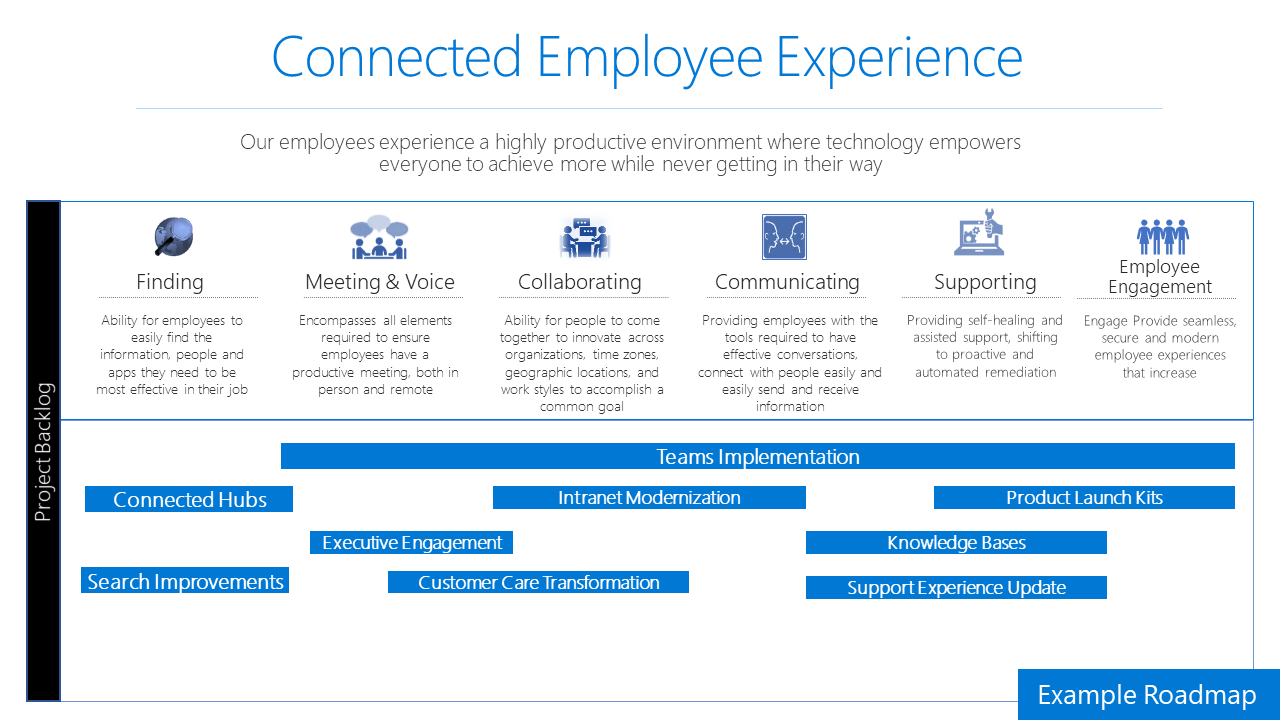
A slide showing an example roadmap. It has six sections in the header; Finding, Meeting & Voice, Collaborating, Communicating, Supporting, and Employee Engagement.
Portfolio management is the ability to design and manage an individual improvement project or a portfolio of improvements into a cohesive employee experience roadmap for your organization. It requires all the skills listed above. A roadmap that delivers improvements to the employee experience must balance the needs of customers, measurable business outcomes, technical capabilities, and culture to deliver change in the right-sized bites for your organization.
This roadmap is crafted in partnership between Service Adoption Specialists and their IT counterparts. Creating the roadmap in collaboration with stakeholders, executives, success owners, and key talent is critical. You need each of these groups to give input and approval to the vision and the speed at which it will become a reality.
You may have been a project or portfolio manager in the past, so risk and issue management are familiar. In this context, your success is not solely measured by delivering an in-scope or on-budget project; you'll also be measured by the employees whose experience you are changing. Either officially or unofficially their experience of the change and your communication around the change play a significant role in your success.
In the context of this training, we assume you are implementing one change at a time. In the real-world, multiple changes occur at once. Though you might not be directly responsible for all the changes, you may need to coordinate with other project and portfolio managers to ensure seamless coordination.
Knowledge area - Leadership

Finally, the last knowledge area is leadership. Leadership is the ability to inspire a group of people to do things they may have never done before, to bring clarity to the chaos, and to hunt down and mediate conflicts and issues as they occur. Leadership through change is the "X" factor and may require the most personal growth from you, depending on your path to service adoption.
When you do this work well, you're delivering beneficial, material change based on data and analysis to a group of individuals who will impact your customers, your market share, and the future of your company. You're delivering change for a cause, not for the sake of change. This is a fundamental difference between you and others. You may have been a service champion previously, directly helping employees get the most from technology. You're likely motivated to help others, and that commitment to improving employees' experience will give you strength exactly when you need your "X" factor to kick in.
The "X" factor isn't an ephemeral thing that only some people are born with. No, not at all. You can develop leadership skills. You can develop your ability to negotiate, resolve conflicts, clarify objectives, understand financial elements, and find your voice.
It's important here to talk about the "introvert leader." This person has a quiet demeanor. They're not the first or last to speak in a meeting, but when they do speak, it's worth listening. This kind of leader normally likes to review information ahead of time so they can reflect on the information before reacting. There's a great deal of room in the service adoption field for this type of leader, so if this describes you, don't feel as though you immediately have to talk more. To the contrary, listening is a critical skill - you may be further ahead in developing that talent than those who are more extroverted and talkative by nature. As in technology, but especially in this area, diversity of style is welcome. Everyone can have an impact in the service adoption community.
